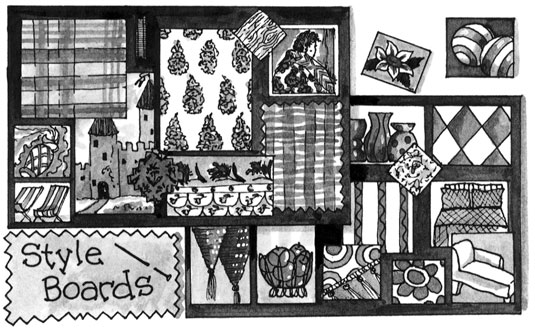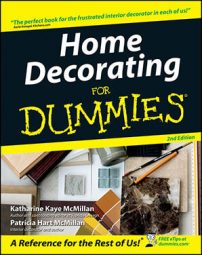As you begin your interior design project, it can help you to create a style board to craft your color scheme and collect samples of fabrics, colors, and inspiring photographs. Arrange these on a large sheet of white paper or poster board. Professional designers use these to show clients how the room might look.

Collect your color and material swatches from actual samples. You have several options when obtaining samples from retailers:
Some samples (laminate countertops, paint, and so on) are free. You may have to purchase others.
Some retailers allow you to check out samples as long as you return them. They may request a deposit. Many retailers credit deposits to your account when you buy.
Brochures, magazine pictures, or even colored slips of paper (available from art stores) work well. Having actual carpet, paint, and fabric swatches to place together to form relationships is the best option, but pictures will do in a pinch.
If you use foamcore or poster board for your style board, attach your photos, swatches, and so on so that they can be easily removed. You can then reuse your boards.
The larger the sample, the better. Big samples give you a truer idea of how a color will look when it’s covering an expanse of wall, floor, or furniture.
Evaluate your completed plan under the same lighting conditions that you’ll be using in your decorated room. Your finished room should look as first-class as (and probably even better than) your style boards.
As you work with various color schemes, keep these tricks in mind:
To make a room look bigger, use light, cool colors to create an atmospheric look. Paint all surfaces the same color. Match the upholstery to the floor. Use contrasting textures to add interest.
To make an average-sized room seem cozier, use medium-tone, warm neutrals. Decorative wall features like wainscoting (wood paneling that comes about halfway up the wall) or paneling make great accents. Use contrasting paint for paneling, and either match or contrast the molding.
To make a ceiling look higher, use white paint or a lighter value of the wall color. Keep floors relatively light.
To square off a long, rectangular room, paint or paper the long narrow walls in light, cool colors to make them recede. Make the short walls advance by using a dark, warm color.
To narrow a wide room, use deeper, warm neutrals on long walls, and lighter cool tints on shorter walls.
To darken a high ugly ceiling, use black, dark gray, midnight blue, or even the same dark, intense color (such as hunter green or chocolate brown) you may be using on a wall.
If the room has varying ceiling heights, don’t hesitate to paint them different colors. Paint a dropped acoustical tile ceiling the same color as the wall. Paint a raised ceiling white or a light contrasting color. The acoustical tile ceiling will seem to disappear! Hooray.

